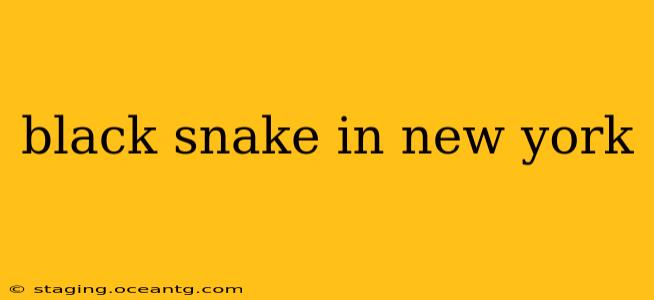New York, with its diverse ecosystems ranging from bustling urban areas to sprawling wilderness, provides habitat for a variety of snake species. While the term "black snake" can be somewhat ambiguous, referring to several dark-colored snakes, this guide focuses on the common black snakes found in New York and provides crucial information for residents and visitors alike. We'll address common concerns and questions regarding their identification, behavior, and how to coexist peacefully.
What Kinds of Black Snakes Live in New York?
Several species of snakes in New York could be described as "black snakes," depending on their coloration and age. The most commonly encountered include:
- Black Rat Snake (Pantherophis obsoletus): This is arguably the most common snake mistaken for a black snake in New York. While they can be black, they often exhibit variations in color, sometimes displaying a pattern of brown or grey. They are large, non-venomous constrictors.
- Eastern Black Racer (Coluber constrictor): These snakes are typically a shiny black color, and as their name suggests, they are fast-moving. They are also non-venomous.
- Northern Black Racer (Coluber constrictor constrictor): A subspecies of the Eastern Black Racer, often found in similar habitats.
It's important to note that other snakes, particularly young individuals of other species, might appear dark or black. Accurate identification requires careful observation of characteristics beyond just color.
Are Black Snakes in New York Dangerous?
No, the black snakes commonly found in New York are not venomous. They are constrictors, meaning they kill their prey by squeezing it. While a large black rat snake might give a frightening bite if handled roughly, it poses no real threat to humans. Their bite is comparable to a dog's nip, more startling than harmful.
What Should I Do If I See a Black Snake?
The best course of action when encountering a black snake is to observe it from a safe distance and leave it alone. These snakes are beneficial to the ecosystem, helping control rodent populations. Do not attempt to handle the snake. If the snake is in a location you deem unsafe (like near your home or children's play area), gently guide it away using a broom or similar tool to a more suitable habitat—such as a wooded area or brush pile. Never pick it up with your hands.
How Can I Prevent Black Snakes From Entering My Home?
Black snakes are generally not interested in entering homes unless they are seeking shelter or food. Keeping your property clean and tidy, sealing any cracks or gaps in your foundation or siding, and removing potential rodent food sources can reduce their likelihood of entering your home.
What Do Black Snakes Eat?
The diet of black snakes in New York varies depending on the species and their size but typically includes rodents (mice, rats), small birds, amphibians, and reptiles. Their role in controlling rodent populations is beneficial for the environment and can save homeowners the hassle of infestations.
Are Black Snakes Protected in New York?
While not all black snakes are specifically listed as protected, they are generally protected under broader state laws that protect wildlife. It’s illegal to kill or harm them without proper permits.
How Can I Identify a Black Snake?
Accurate identification requires observing several features beyond just color. Look for things like:
- Size and Body Shape: Black rat snakes can grow quite large, whereas racers are more slender.
- Scales: Note the pattern and arrangement of scales.
- Head Shape: The head shape can differ between species.
- Location: Where you encountered the snake can provide clues.
If you're unsure about identification, consulting a herpetologist or using reputable online resources with detailed identification guides is recommended.
Disclaimer: This information is for educational purposes only. Always exercise caution when interacting with wildlife. If you are bitten by any snake, seek immediate medical attention.
